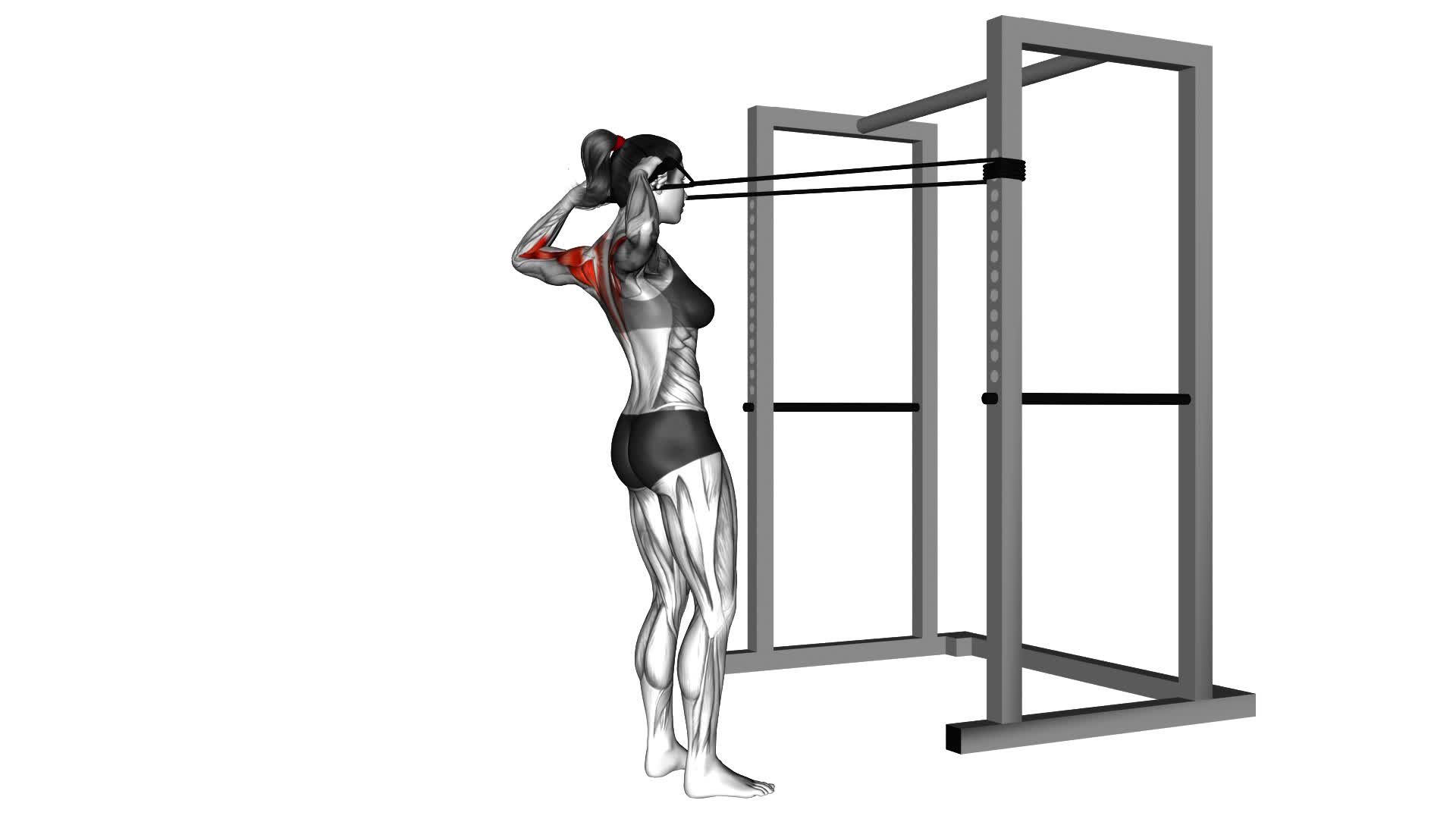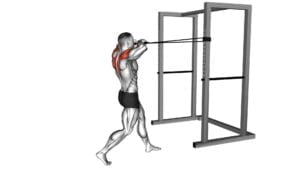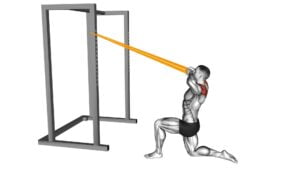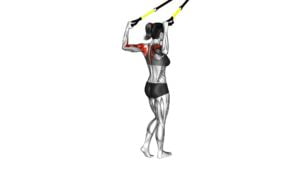Band Face Pull – Video Exercise Guide & Tips

Looking to strengthen your upper back and improve your posture? The Band Face Pull is the perfect exercise for you.
Watch This Exercise Video
In this video exercise guide, we'll show you how to properly perform the Band Face Pull using a resistance band.
You'll learn the benefits of this exercise, the equipment you'll need, and tips for maximizing its effectiveness.
Say goodbye to slouching and hello to a stronger, more confident you.
Let's get started!
Key Takeaways
- The band face pull is an effective exercise for strengthening the upper back and shoulders.
- It targets muscles like the rhomboids and rear deltoids, helping to improve posture and upper body strength.
- Engaging the shoulders and rotator cuff muscles can enhance athletic performance and improve daily activities.
- Using a resistance band and a sturdy anchor point, such as a door frame or squat rack, can provide versatile and affordable equipment for this exercise.
Benefits of the Band Face Pull
One of the primary benefits of the Band Face Pull is its ability to strengthen your upper back and shoulders. This exercise specifically targets the muscles in your upper back, such as the rhomboids and rear deltoids, while also engaging your shoulders and rotator cuff muscles. By regularly performing the Band Face Pull, you can improve your posture and upper body strength, which can have a positive impact on your overall athletic performance and daily activities.
Additionally, the Band Face Pull is an effective exercise for improving shoulder stability. The pulling motion of the exercise activates the muscles that support your shoulder joint, helping to prevent injuries and improve your joint function. This is especially important for individuals who participate in activities that require overhead movements, such as throwing, swimming, or weightlifting.
Incorporating the Band Face Pull into your workout routine can also help alleviate any muscle imbalances that may be present in your upper body. Many individuals tend to have stronger chest muscles compared to their back muscles, which can lead to poor posture and increased risk of injury. The Band Face Pull helps to counteract this by strengthening the muscles in your upper back, promoting better balance and stability.
With its ability to strengthen your upper back and shoulders, improve shoulder stability, and address muscle imbalances, the Band Face Pull is a valuable exercise to include in your fitness routine. To perform this exercise, you'll need a resistance band and a sturdy anchor point, such as a door frame or a squat rack.
Equipment Needed for the Exercise
To perform the Band Face Pull exercise, you'll need a resistance band and a sturdy anchor point, such as a door frame or a squat rack. Resistance bands are a versatile and affordable piece of equipment that can be easily transported and used in various exercises. They come in different levels of resistance, allowing you to adjust the intensity of your workout.
When choosing a resistance band, it's important to consider your fitness level and the target muscles you want to work on. Thicker bands provide more resistance, while thinner bands offer less resistance. It's recommended to start with a lighter resistance band and gradually increase the intensity as you become more comfortable with the exercise.
Proper form is crucial when performing the Band Face Pull exercise. Here are some tips to ensure you're doing it correctly:
- Stand with your feet shoulder-width apart and hold the resistance band with both hands.
- Step back to create tension in the band, keeping your arms extended in front of you.
- Slowly pull the band towards your face, leading with your elbows and squeezing your shoulder blades together.
- Pause for a moment and then slowly return to the starting position.
Proper Form and Technique
To perform the Band Face Pull exercise with proper form and technique, follow these steps:
- Stand with your feet shoulder-width apart and hold the resistance band with both hands.
- Attach the resistance band to a secure anchor at chest height.
- Grab the band with an overhand grip, palms facing down, and extend your arms in front of you.
- Keep your shoulders relaxed and your core engaged.
To initiate the movement:
- Squeeze your shoulder blades together and pull the band towards your face.
- Focus on pulling with your upper back muscles, rather than using your arms.
- Keep your elbows high and your wrists straight throughout the movement.
Maintain a slow and controlled tempo, resisting the urge to use momentum. As you pull the band towards your face:
- Imagine squeezing a pencil between your shoulder blades.
- This will help to activate the muscles in your upper back and promote proper form.
By performing the Band Face Pull exercise correctly:
- You'll effectively target your rear deltoids, rhomboids, and upper back muscles.
- This exercise is great for improving posture and strengthening the muscles that are often neglected in our daily activities.
Now that you have learned the proper form and technique for the Band Face Pull, let's move on to the next section to discuss common mistakes to avoid.
Common Mistakes to Avoid
To avoid common mistakes and ensure proper execution of the Band Face Pull, pay attention to your body positioning and the tension in the resistance band. Here are some common mistakes to avoid and proper form techniques to keep in mind:
- Mistake 1: Incorrect Body Positioning
- Avoid leaning backward or arching your lower back excessively during the exercise. This can strain your lower back and compromise the effectiveness of the movement.
- Instead, maintain a neutral spine position throughout the exercise. Keep your core engaged and your shoulders relaxed.
- Mistake 2: Lack of Tension in the Resistance Band
- Many people tend to use a resistance band that's too loose, resulting in reduced effectiveness of the exercise.
- Ensure that the resistance band is properly anchored and provides enough tension to challenge your muscles. This will help you engage the targeted muscles effectively.
Variations and Progressions
Continue building upon your Band Face Pull exercise by incorporating variations and progressions. By using different grips and adjusting the resistance levels, you can target different muscles and challenge yourself further.
To add variety to your Band Face Pull, try using different grips such as a pronated grip (overhand grip) or a supinated grip (underhand grip). This will change the angle of the exercise and engage different muscles in your back and shoulders.
Another way to progress is by increasing the resistance levels of the band. This can be done by using a thicker band or adding multiple bands for increased tension. By increasing the resistance, you'll increase the challenge and stimulate more muscle fibers.
Incorporating variations and progressions into your Band Face Pull routine will keep your workouts interesting and help you continue making progress. It allows you to target different muscles and prevent plateauing. By challenging yourself with different grips and resistance levels, you can continue to build strength and improve your overall fitness.
Now that you understand the variations and progressions of the Band Face Pull exercise, let's move on to the next section where we'll discuss tips for maximizing the exercise's effectiveness.
Tips for Maximizing the Exercise's Effectiveness
To maximize the effectiveness of the band face pull exercise, it's important to focus on proper form techniques.
Ensure that you maintain a neutral spine, engage your core, and keep your shoulders relaxed.
Additionally, target specific muscle groups by consciously squeezing your shoulder blades together and pulling the band towards your face.
Proper Form Techniques
You should regularly perform the band face pull exercise with proper form to maximize its effectiveness. Here are some tips to ensure you're executing the exercise correctly:
- Common Mistakes
- Avoid using too heavy of a resistance band, as it can lead to poor form and reduced muscle engagement.
- Don't pull the band too close to your face, as this can strain your neck and shoulders.
- Muscle Engagement
- Focus on squeezing your shoulder blades together as you pull the band towards your face. This will engage your upper back muscles more effectively.
- Keep your elbows high and wide, making sure to engage your rear deltoids and upper back muscles throughout the movement.
Targeting Specific Muscle Groups
To maximize the effectiveness of the band face pull exercise, focus on engaging your target muscle groups by maintaining proper form. Muscle activation is crucial when performing any exercise, and the band face pull is no exception.
This exercise primarily targets the posterior deltoids, rhomboids, and upper back muscles. To ensure optimal muscle activation, start by standing with your feet shoulder-width apart and holding the resistance band with a pronated grip.
Pull the band towards your face while keeping your elbows high and wide, squeezing your shoulder blades together at the end of the movement.
Frequently Asked Questions
How Many Times a Week Should I Perform the Band Face Pull Exercise?
To get the most out of the band face pull exercise, you should perform it multiple times a week.
This exercise offers numerous benefits, such as targeting your rear delts and upper back muscles.
By incorporating band face pulls into your routine, you can improve your posture, strengthen your shoulder muscles, and enhance overall upper body strength.
There are also variations of the band face pull that you can try to add variety and challenge to your workouts.
Can I Substitute Resistance Bands With Dumbbells or Cables for This Exercise?
Yes, you can substitute resistance bands with dumbbells or cables for the band face pull exercise.
This allows for variations in your workout routine and targets your shoulder and upper back muscles in different ways.
Using dumbbells or cables provides a different type of resistance, which can help with muscle growth and strength development.
However, make sure to maintain proper form and technique to avoid any potential injury.
Is the Band Face Pull Suitable for Beginners or Is It More Advanced?
The band face pull is a versatile exercise that can be modified to suit your fitness level. It's suitable for beginners as it helps improve shoulder health and posture. By using resistance bands, you can gradually increase the intensity as you progress.
The benefits of the band face pull include strengthening the upper back and shoulders, improving scapular stability, and reducing the risk of shoulder injuries. Incorporating this exercise into your routine can yield great results.
Are There Any Specific Muscles Targeted by the Band Face Pull Exercise?
The band face pull exercise targets specific muscles in your upper back and shoulders. It helps to activate the rear deltoids, rhomboids, and rotator cuff muscles.
By using a resistance band, you can adjust the intensity of the exercise to suit your fitness level. Variations and progressions can be made by changing the resistance band tension or using different hand positions.
These modifications allow you to continually challenge your muscles and make progress over time.
Can Incorporating the Band Face Pull Into My Workout Routine Improve My Posture?
Incorporating the band face pull into your workout routine can greatly improve your posture.
This exercise specifically targets the muscles in your upper back and shoulders, which play a crucial role in maintaining proper posture.
By strengthening these muscles, you can reduce rounded shoulders and improve your overall alignment.
The band face pull also helps to counteract the effects of sitting at a desk all day, which can contribute to poor posture.
Conclusion
To conclude, the band face pull is a highly effective exercise for targeting the muscles in the upper back and shoulders. By using a resistance band, this exercise helps to improve posture, strengthen the rear delts, and prevent shoulder injuries.
It's important to maintain proper form and technique to avoid common mistakes and maximize the exercise's effectiveness. With variations and progressions, this exercise can be tailored to individual fitness levels.
Incorporating band face pulls into your workout routine will yield great results.

Author
Years ago, the spark of my life’s passion ignited in my mind the moment I stepped into the local gym for the first time. The inaugural bead of perspiration, the initial endeavor, the very first surge of endorphins, and a sense of pride that washed over me post-workout marked the beginning of my deep-seated interest in strength sports, fitness, and sports nutrition. This very curiosity blossomed rapidly into a profound fascination, propelling me to earn a Master’s degree in Physical Education from the Academy of Physical Education in Krakow, followed by a Sports Manager diploma from the Jagiellonian University. My journey of growth led me to gain more specialized qualifications, such as being a certified personal trainer with a focus on sports dietetics, a lifeguard, and an instructor for wellness and corrective gymnastics. Theoretical knowledge paired seamlessly with practical experience, reinforcing my belief that the transformation of individuals under my guidance was also a reflection of my personal growth. This belief holds true even today. Each day, I strive to push the boundaries and explore new realms. These realms gently elevate me to greater heights. The unique combination of passion for my field and the continuous quest for growth fuels my drive to break new ground.







